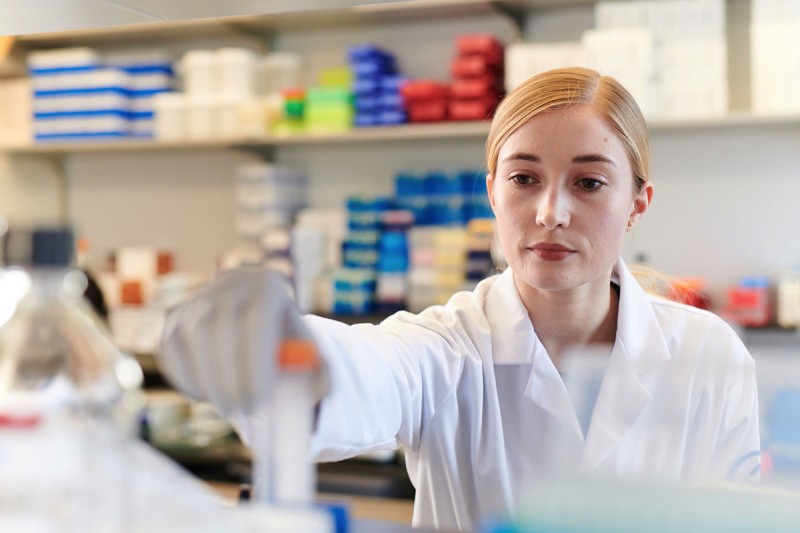
Paige Arnold, who will graduate from the Gerstner Sloan Kettering Graduate School of Biomedical Sciences (GSK) next spring, has been awarded the 2022 Chairman’s Prize. The competitive award is presented annually and was established by GSK’s Board of Trustees Chair Emeritus Louis V. Gerstner, Jr., for whom the school is named.
This year’s Chairman’s Prize, in the amount of $2,000, honors Arnold’s research, which she conducted in the laboratory of Lydia Finley, Assistant Professor of Biology at the Sloan Kettering Institute (SKI). The Finley Lab studies how metabolic pathways regulate stem cells and cancer cells.
Below, Arnold describes her winning thesis work, which characterizes a novel, alternative tricarboxylic acid (TCA) cycle that is a major driver of the metabolic diversity observed across mammalian cells. The research sought to understand how this metabolic diversity is achieved, and whether it is important for the establishment of cell identity. The study was published in Nature, and Arnold shared co-first authorship with lab mate and fellow GSK student Benjamin T. Jackson.
Cellular metabolism — or how cells make energy and accumulate the raw materials that they need to grow and divide — is important for both normal cell development and abnormal development, which can lead to diseases like cancer.
A non-canonical tricarboxylic acid cycle underlies cellular identity
The tricarboxylic acid (TCA) cycle is a core metabolic pathway that oxidizes nutrients to generate reducing equivalents for cellular energy production and critical metabolites used for biosynthetic reactions. Despite the crucial role of TCA cycle-derived products in supporting cell viability and proliferation, mammalian cells exhibit significant diversity in TCA cycle activity. How this diversity is achieved, and whether it is important for the establishment of cell identity, remains largely unexplored. Here, we sought to identify drivers of TCA cycle heterogeneity and determine whether TCA cycle plasticity is required for successful cell-state transitions.
The observed heterogeneity in TCA cycle activity led us to hypothesize that cells might selectively engage components of the TCA cycle to meet their metabolic demands. To test this idea, we performed genetic co-essentiality mapping, an unbiased approach that clusters genes into functional modules by harnessing genome-wide CRISPR screening data from hundreds of cancer cell lines. This analysis revealed that TCA cycle genes cluster into two distinct metabolic modules, one of which is the canonical pathway characterized by Sir Hans Krebs. The second module comprises a biochemical alternative to the traditional TCA cycle, in which citrate is exported to the cytoplasm and metabolized by ATP citrate lyase (ACL), producing oxaloacetate that can be recycled back into the mitochondria to support continuous citrate regeneration. We reasoned that significant engagement of this metabolic pathway could be read out as a drop-off in 13C-glucose labeling downstream of citrate, as citrate metabolism by ACL liberates glucose-derived carbons in the form of acetyl-CoA. Our analysis of published isotope tracing data revealed that many cultured cell lines exhibit dramatic loss of 13C-glucose-derived label in TCA cycle metabolites downstream of citrate; we found that we could mitigate this label loss in select cancer cell lines by treatment with an ACL inhibitor. These results indicate that citrate metabolism via ACL represents a major metabolic pathway in cancer cells.
To test whether non-transformed cells engage this “non-canonical” TCA cycle, we generated clonal mouse embryonic stem cell (ESC) lines deficient for Acly and similarly observed that ACL loss reduced the disconnect between glucose labeling of citrate and downstream TCA cycle metabolites. Critically, an orthogonal isotope tracing approach demonstrated that Acly disruption diminished production of mitochondrial citrate derived from cytoplasmic intermediates, indicating that ACL directly mediates citrate recycling. ACL loss also caused dramatic disruption of steady-state levels of TCA cycle metabolites while loss of the canonical TCA cycle enzyme aconitase 2 (ACO2) had comparatively little effect on TCA cycle dynamics. Thus, a significant portion of the TCA cycle transits through the cytoplasm in an ACL-dependent manner in both normal and transformed cells.
Krebs originally elucidated the traditional TCA cycle in pigeon breast muscle. We therefore asked whether TCA cycle configuration is cell-state dependent by culturing C2C12 mouse myoblasts, which can be differentiated in vitro into mature myotubes. In accordance with Krebs’ work, we found that myogenic differentiation is accompanied by a switch from ACL-dependent to more traditional TCA cycle metabolism. Next, we utilized ESCs to study TCA cycle dynamics during changes in cell fate as these cells can be driven into the naive, ground state of pluripotency or induced to exit from the pluripotent state. We found that the acquisition of naive pluripotency is coupled with increased traditional TCA cycle engagement and thus is blunted by ACO2 loss. In contrast, exit from naive pluripotency drives a shift toward non-canonical TCA cycle metabolism; consequently, loss of ACL prevents this metabolic shift and blocks ESCs from exiting the pluripotent state. These results demonstrate that TCA cycle activity is plastic and successful cell state transitions require appropriate TCA cycle engagement.
Non-canonical TCA cycle utilization offers several advantages to growing cells, including retention of reduced carbon that would otherwise be lost as carbon dioxide and regeneration of cytosolic NAD+, a limiting cofactor for biosynthetic reactions. This pathway thus represents a metabolic strategy that can be differentially engaged by cells depending on their unique growth and bioenergetic requirements. Collectively, this work characterizes a novel, alternative TCA cycle that is a major driver of the metabolic diversity observed across mammalian cells
